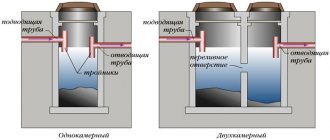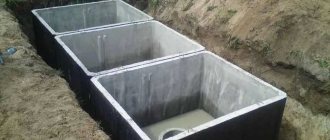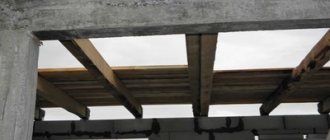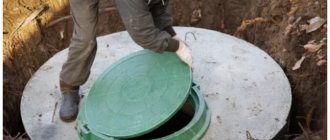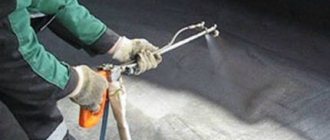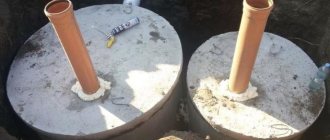A modern country house is equipped with many technological benefits that were unavailable even a couple of decades ago and the functioning of which requires water. In addition to cooking and washing hands, there is at least a shower, a washing machine, and maybe also a dishwasher. For all these devices, it is necessary to establish not only the supply of clean water, but also the drainage of the resulting wastewater. This means that the usual level of convenience cannot be imagined without a modern device for treating household wastewater. When it is impossible to connect a house to a central collector, a septic tank made of reinforced concrete rings can be one of the few ways that allows you to properly process waste and prevent soil contamination.
View of a septic tank made of concrete rings in the courtyard of a private house Source mirhat.ru
How does a septic tank work?
For a small private house, a septic tank made of concrete rings is installed according to the classic scheme, including two tanks. If a significant volume of wastewater is expected, three tanks (wells) are installed, different in design and functionality. The first two wells are made hermetically sealed; in the third, a crushed stone filter is installed, through which the water flows into the soil.
The principle of constructing a septic tank made of concrete rings Source admiral-oz.ru
Purpose and design of cameras
- The first septic well serves to receive and settle wastewater. Here, thanks to the work of anaerobic bacteria, sedimentation occurs and partial treatment of wastewater occurs (Anaerobic bacteria are able to decompose complex organic matter into simple substances without access to oxygen). The initially clarified water flows into the second section. The volume of the chamber should be equal to half of the total planned volume of the system; its base is concreted.
- In the second well (drainage) with sealed walls and bottom, additional filtration occurs. Additional filters made of gravel can be installed here.
- In the third well, final filtration occurs. The bottom here is not concreted; a sand-crushed stone (or sand) mixture is poured in for final filtration.
Principle of operation
Let's start with the fact that there are two types of septic tanks: two-chamber and multi-chamber. The two-chamber one is the simplest in design. Its components: a settling tank, where a three-day process of separating wastewater into liquid and solid waste takes place; a filter well without a sealed bottom, into which purified water flows from the sump and goes into the ground. In order for the filter well to be less polluted and the quality of water purification to be better, several settling tanks can be combined into a sequential chain.
A multi-chamber septic tank is different in that when used, the degree of wastewater purification is much higher, and removing sediment from it is faster and more convenient. But it is important to know that even a ten-day septic tank will not completely clean the wastewater, since the bulk of the sediment is in the 1st section, without re-contaminating the water with waste products.
Advantages and disadvantages of a septic tank made of concrete rings
Due to the features of use, design and installation, such a system is the optimal solution in many cases.
Let's consider all the pros and cons of septic tanks made of concrete rings:
Its advantages include:
- simple installation and use technology. There is no need to supply electrical power, arrange additional drainage, or install a pump;
- reliable autonomous design with high mechanical strength;
- complete freedom in choosing the dimensions of the structure;
- long service life;
- large useful volume and easy maintenance;
- resistance to aggressive wastewater environment;
- the weight of the rings is a guarantee that groundwater will not displace the septic tank from the soil;
- available materials and reasonable price for building a septic tank.
How to install a sump tank?
Consider the installation of a two-chamber septic tank. In the pit, the bottom is filled with sand to a depth of 100-150 mm and watered for the best shrinkage.
The next concrete ring is installed on a solution in proportions - 1 cement: 3 sand: 0.1 liquid glass. It is necessary to prepare the solution in small portions, since it must be used within half an hour.
1 — rings of the working part; 2 — insulating cover; 3 — neck rings; 4 — hatch body; 5 — hatch cover; 6 — ventilation riser; 7 - floor slab; 8 — bottom plate; 9 — crushed stone cushion; 10 - waterproofing; 11—sediment zone; 12 — running brackets
The cover with the hatch is installed on a bed of sand-cement mortar.
The sump requires waterproofing with two layers of hot bitumen or coating with a water-repellent composition.
Making the right calculations: capacity and design
At the design stage, a septic tank diagram is created from concrete rings, then the volume of the future device is determined:
Number of cameras
The number of cameras depends on the number of people using the sewer system. If a family actively uses the shower, bathtub, and appliances, the drain down the drain will be significant. The drains will require thorough cleaning, for which you will need a septic tank of three wells, two of which will be settling chambers.
Diagram of a septic tank made of concrete rings Source tolkobeton.ru
Capacity
To determine the volume of wastewater entering the septic tank from the kitchen, bathhouse and toilet, you need to calculate the daily water consumption. Knowing that the daily rate of domestic water consumption for one resident is equal to 200 liters, it is easy to calculate that a family of 4 people will fill the septic tank at a rate of 800 liters per day.
The quality of the septic tank improves if wastewater lingers in the chambers for a long enough time. By increasing the volume, you can improve the quality of the wastewater and protect the system from clogging with difficult-to-decompose fat.
According to building codes, the installation must accommodate wastewater that is generated over three days (the daily flow rate must be multiplied by 3). This number determines the volume of the septic tank and the number of chambers:
- a single-chamber septic tank is installed if daily waste does not exceed 1 cubic meter;
- two-chamber – up to 5 cubic meters;
- three-chamber – 8 or more cubic meters.
In a septic tank with two chambers, the first sump occupies the volume of 2/3 of the entire septic tank, in a three-chamber septic tank - half.
Design features, nuances of use
Purely structurally, a septic tank is a well assembled from reinforced concrete rings installed on top of each other. If the volume of sewage discharged is no more than 1 m³/day, then one well is sufficient.
If the wastewater volume is 1-10 m³/day, then two wells are installed. This type of septic tank is called a two-chamber septic tank. If more than 10 m³/day of sewage is discharged into the sewer system, then there can be an infinite number of wells, depending on the volume of wastewater. On suburban private plots, structures of more than three wells are usually not used.
The arrangement of the latter relative to each other can be as follows: sequential, circular, letter “G”, etc. Here it is important to correctly connect the wells to each other, for which a regular plastic sewer pipe is used.
Attention! The number of chambers does not affect the quality of cleaning. The larger influence is the volume of the structure. The larger it is, the more intense the sedimentation of sewage occurs.
Video description
About septic tanks on high groundwater in the video:
See also: Catalog of companies that specialize in utilities: water supply, sewerage, heating.
Increased structural strength:
- To protect the building from possible ground movements and shifting of the rings, they are additionally secured with metal ties.
- To reduce the subsidence of the septic tank and improve its thermal insulation and drainage, during installation a cushion of sand, crushed stone or gravel is placed around it.
How to correctly calculate capacity
To do this, two indicators are taken into account:
- The number of people permanently living in the house. Guests are not included.
- The amount of water consumed by one person per day. This is a standard value - 200 liters or 0.2 m³. This indicator includes: using the toilet, washing dishes, showering, washing and other procedures related to water.
For example, if there are 4 people living in a house. Then you need to build a septic tank with the following volume:
4 x 0.2 = 0.8 m³.
But there is one more indicator that is recommended to be taken into account when making calculations. This is the number of days during which bacteria process organic matter in sewage, turning it into activated sludge. Its value is 3 days. The final result will be like this:
0.8 x 3 = 2.4 m³.
How to choose a concrete ring
The dimensions of reinforced concrete products are known. And each has its own standard volume. For example, if a diameter of 1 m is selected. It turns out that the volume of one ring is:
0.9 x (πD²)/4 = (0.9 x 3.14 x 1)/4= 0.7 m³
The same can be done with other sizes:
| Diameter of reinforced concrete products, m | Volume, m³ |
| 1,5 | 1,6 |
| 1,7 | 2 |
| 2 | 2,83 |
The required volume of the septic tank is 2.4 m³. For it, either 4 rings with a diameter of 1 m, or two rings with a diameter of 1.5 m, or 2–1.7 m, or one two-meter are suitable. That is, the total volume of the rings should not be less than the required value.
The choice of diameter is also influenced by the groundwater level in the area. If it is tall, then it is better to give preference to a wide product, the depth of which will not be large.
How much will the rings cost?
Concrete rings are selected based on calculations of the volume of the septic tank. The dimensions of concrete rings for a septic tank are indicated on the marking. They are characterized by the height, diameter and thickness of the walls of the structure, as well as the type of product:
- KS – wall ring, suitable for erecting walls;
- PP – floor slabs;
- PD – road slabs, installed at the bottom of the pit.
The cost of concrete rings is affected by their size and location of production. Reinforced concrete rings with low surface permeability, resistant to aggressive environments, are suitable for sewerage.
The height can be 290, 590, 800, 900 mm. A typical product with a height of 900 mm can have a diameter of 700, 800, 1000, 1500 and 2000 mm. The average price for it varies from 1200 to 1800 rubles. Rings with other parameters can cost from 680-1050 to 1500-2400 rubles.
Rings for septic tank Source humphrey.alpvd.ru
It should be remembered that some rings are marked with an internal (useful) diameter, while others have an external diameter, which is important for selecting caps. The average cost of a reinforced concrete cover or polymer hatch ranges from 1,700 to 2,000 rubles.
When drawing up an estimate for a septic tank made of concrete rings, the price takes into account additional materials: pipes, cement, sealant, as well as the cost of work (digging, installation of rings). The final average price of a turnkey septic tank is in the range from 38,000 to 69,000 rubles.
How to save on construction?
If it is not possible to use special equipment during installation and finances do not allow you to attract a team of workers, try using these methods.
Instead of traditionally digging a pit and then immersing rings in them, use a technology in which the soil is removed gradually as the ring is deepened. It is built on the fact that the ring falls down under the influence of its weight. The master’s task is to dig up the soil inside the ring and under its wall.
The technology of “undermining” rings laid on the ground is used only when installing products without a bottom
In this case, the concrete bottom will have to be poured later. And it will be located exclusively inside the ring.
A significant drawback of the described method is the inability to perform thermal and waterproofing on the outer walls of the structure. In addition, due to the fact that the bottom is located inside the ring, the reliability of the structure is reduced.
In an effort to reduce the cost of the structure itself, craftsmen offer an option for constructing a structure that looks like a triangle.
Storage tanks act as the basis of an isosceles triangle, and their common neck is its vertex
By choosing this arrangement option, you will save space for placing rings and can significantly reduce the amount of land work.
But during installation, take into account the peculiarity that the inspection entrance in such a design will be one per three rings. Therefore, all overflows should be placed outside its accessibility.
Video description
The work procedure and installation of a septic tank made of concrete rings in the video:
How to choose the optimal location for a septic tank
The structure is mounted above the groundwater level. The best location is at the maximum distance from the house (at least 7 meters, but no more than 20, so as not to increase the cost of pipeline construction). It is logical to place the septic tank on the border of the site, next to the road. This will reduce operating costs, since the cost of leaving a sewage tank is affected by access to the system and the length of the hose. In addition, with the correct location, the sewage disposal truck does not need to enter the yard, and the hoses will not lie on the beds or paths (otherwise, when the hose is rolled up, waste may end up in the garden).
The distance to the nearest source of drinking water (well, borehole) is at least 30 (and if possible more) meters.
Pit preparation
Ground work using an excavator takes 2-3 hours. The size of the pit should be slightly larger than the dimensions of the wells. This is necessary for the smooth installation of the rings and their waterproofing. The bottom is covered with crushed stone and concreted.
Preparing a pit for a septic tank made of concrete rings Source rostovgruz.ru
Location of the structure
When designing a septic tank, the sanitary zone is placed in such a way that organic waste cannot penetrate into drinking water and fertile soil. To do this, when choosing a location, you should be guided by sanitary and building codes and regulations.
The correct location of the cleaning system on the site is regulated by:
- SNiP 2.04.03.85. It sets out the rules for the construction of external sewerage structures.
- SanPiN 2.2.1/2.1.1.1200-03. It lists the requirements for creating zones that are environmentally hazardous.
According to the standards, in order to avoid the foundation getting wet in the event of emergency leaks, the septic tank must be placed lower than the house is located.
Failure to comply with these requirements may result in a risk of untreated wastewater penetrating into aquifers (+)
When choosing a location, you should definitely take into account the presence of bodies of water with running water, maintaining a distance of 5 m to them. The distance from trees should be 3 m, from bushes - reduced to one meter.
It is also necessary to know where the underground gas pipe is laid. The distance to it should be at least 5 m.
Since the construction of purifier chambers from rings involves the construction of a pit and the use of special equipment, when choosing a location it is worth providing free space for its access and maneuvering
But keep in mind that the machine cannot be placed directly above the deepening site of the treatment plant. With their weight they can destroy the entire structure.
How to put a septic tank into operation
In order for the system to begin to function effectively, the constructed septic tank must be saturated with anaerobic microflora. The natural accumulation process takes several months, so it is accelerated by saturating the septic tank with imported microflora. You can do this in two ways:
- The new septic tank is filled with wastewater and left for 10-14 days. Then sludge sludge from an existing anaerobic septic tank is loaded into it (2 buckets per cubic meter).
- You can purchase ready-made bioactivators (bacterial strains) in the store (the main thing here is not to confuse them with aerobes, which are intended for other treatment systems).
Ready-to-start septic tank made from rings Source remont-book.com
Construction options
Most often, one-, two-, or three-level septic tanks are used in suburban areas. In this case, the first septic tank is always sealed. This is where the majority of sewage solids settle.
The remaining wells serve as filter elements. They are not sealed, that is, they do not have a bottom. Secondly, manufacturers today offer perforated concrete rings. Through holes are formed in their walls during the production process.
Single level
This is one well for which filtration fields will need to be built. Or at least a filtration ditch. Not the most effective cleaning option, so it is recommended to construct it from large diameter rings.
Two-level
Ideal for a small country house. Usually the wells are the same size, but this is not necessary. The first one is sealed, the second one is not. They are erected on the same level. But you can lower the second lower than the first.
Three-chamber
From the name it is clear that this is a septic tank of three compartments, which are connected to each other in series, regardless of their location. The arrangement scheme can be as follows: in one line, in the form of the letter “G”, in a triangle.
Typically the first element has a larger volume than the other two individually. Moreover, it is the latter that perform filtration functions. The first is a collection of sewage, where heavy sewage settles.
What rules must be followed when servicing a septic tank?
There are simple rules that support the high-quality operation of the system.
- Cleaning. Twice a year, in addition to cleaning the drains, the septic tank must be inspected and the pipelines cleaned. Once every 5 years (or better yet, every 2-3 years) the bottom heavy fats are removed. The volume of sludge should not exceed 25% of the tank volume. When cleaning, part of the sludge is left to restore the microflora.
- Quality of work. The wastewater leaving the system must be 70% purified. Analysis of wastewater in the laboratory will determine the acidity indicator, which will allow you to find out the quality of the drainage system.
- Security measures:
- Work inside the septic tank is allowed only after intensive ventilation and using a safety belt (gases formed inside can be dangerous to human life).
- Increased safety measures are required when working with power tools (humid environments).
A septic tank made of concrete rings makes private housing more autonomous and, despite its shortcomings, it is one of the most reliable and durable options for treatment facilities for suburban real estate.
Septic tank installation technology
There is nothing difficult in making a reliable and durable septic tank from rings. When designing several compartments, a linear construction principle is used, in which all concrete columns from rings are lined up along one line.
The receiving compartment and the following tanks are placed in close proximity to each other, and the filter column is located at a slight distance from them.
Step #1 - measurements and design
One of the prerequisites for effective wastewater treatment is to create conditions for it to remain inside the walls of the septic tank for at least three days. Therefore, the dimensions of the chambers are determined using the total three-day volume of wastewater as a basis.
According to standards, the daily volume of water consumption per household, subject to the use of household appliances, is about 200 liters.
So for a family of two or three people, the minimum volume of a treatment plant should be about two cubic meters. A family of 5-6 households will require a more spacious structure with a volume of 3-4 cubic meters.
When calculating, only the volume of the septic tank compartments is taken into account; since the filter well is not one of these, it is not taken into account (+)
But when determining the volume of the structure, it is worth making a small reserve. After all, if guests arrive, there is a risk of “overfilling” the norm. And eliminating the consequences is a rather complex and at the same time expensive procedure.
The table below will help you determine what size rings you will need and in what quantity.
Marking and dimensions of manufactured reinforced concrete rings indicating the outer/inner diameter, weight and volume
When choosing rings, keep in mind that the actual volume of the column must be clearly higher than the calculated one. This is due to the fact that as the drains fill, they rise only to the level of the overflow holes and never reach the top edge. Therefore, the calculated volume of liquid must be placed up to the level of these pipes.
Step #2 - preparing the necessary materials
When choosing rings for a septic tank, it is advisable to buy products with locks. The presence of locks not only simplifies the installation process, but also prevents their displacement under the influence of frost heaving. When purchasing products, you need to pay attention to the evenness of the seats and carefully inspect the integrity of the locks.
In addition to the rings themselves, materials and construction tools will also be required:
- sewer pipes;
- fine crushed stone;
- river sand;
- polyurethane foam;
- cement mortar;
- waterproofing compounds;
- rolled thermal insulation materials;
- building level;
- ladder;
- perforator;
- wide brush;
- container for mixing the solution.
To create overflows between wells, you will need asbestos-cement or polypropylene pipes marked “for external sewerage.”
Polypropylene pipes are famous for their strength and elasticity; their operating temperature is about 65°C
The diameter of asbestos-cement or polymer pipes used for overflow should be 110-120 mm.
Step #3 - digging a pit and arranging the bottom
It is better to carry out excavation work after the onset of the first frost or in the hottest months. During this period, the lowest groundwater level is observed.
The pit can be dug manually, by hiring a team of “diggers”, or by using the services of an excavator. If we take into account the costs of carrying out excavation work, then the costs of a team of diggers will be comparable to the amounts that will be spent on calling out special equipment.
The dimensions of the finished pit should exceed the dimensions of the installed rings by 50-80 cm. This will simplify the installation process and allow for external waterproofing of the joints of the structure.
When calculating the pit depth, three values are summed up: the height of the monolithic or filtration bed (20-30 cm) + the height of the rings (indicated in the table) + the height of the slab (15 cm).
It is better to immediately remove a large amount of soil removed from the pit from the site, using the same machine that delivered the rings
The pit for installing the treatment plant should be two-tiered: its second tank should be buried 50 cm lower than the first. Alternatively, dig your own hole for each tank.
To connect sewer pipes, trenches are dug, laying them below the freezing depth of the soil. The width and depth of the trenches are selected based on the dimensions of the rings used for the construction of the tanks. Most often they are made 50 cm wide with a depth of 1.2-1.5 m.
The bottom of the dug trenches should be located at a slope of 2-3 cm, distributed per linear meter. It is better to calculate in advance the difference between the extreme points, multiplying the distance between them by the slope value stated by the standards.
Compliance with this condition will ensure gravity flow of the liquid. The leveled and compacted bottom of the trenches is covered with sand, forming a layer 10 cm thick.
The bottom of the pit is carefully compacted again. For concreting, standard cement mortar prepared in a 3:1 ratio is used.
If you plan to install a lower ring equipped with a bottom, you don’t have to construct a concrete screed. In this case, you can limit yourself to crushed stone filling, forming a layer 20 cm thick.
The bedding created after compaction must have a flat horizontal surface, free of differences
It is necessary to achieve an effect in which the pillow sags as much as possible. To thoroughly compact the embankment and achieve maximum density, tamping is alternated with filling the fill with water.
Step #4 - installing rings and sealing seams
The construction of a septic tank begins with the installation of its closed part - the lower ring, equipped with a bottom. It is set exactly so that the walls are positioned strictly vertically. Compliance with this condition will ensure the strength and stability of the structure.
When using a ring without a bottom as a base, the bottom of the pit must first be concreted. To do this, pour a concrete screed 30 cm thick. The dimensions of the created concrete screed should be 20 cm larger than the diameter of the immersed ring.
An option for pouring the base for a three-chamber septic tank, the tanks of which are arranged not in a straight line, but in the form of a triangle
It can take up to two weeks for the concrete to harden. As soon as it acquires the necessary strength, install the first ring. Laying the rings without outside help is almost impossible. This work is performed with two or three assistants.
To protect the structure from leakage and reduce the harmful effects of groundwater on concrete, the joints between the base and the lower edge of the ring are thoroughly coated with waterproof cement mortar.
Ideal for waterproofing materials:
- bitumen mastic;
- deep penetration impregnation.
As an impregnation for treating concrete rings, it is good to use cement-based compositions such as “Penetron” or “Aquacement”.
When sealing joints, liquid glass is often added to cement mixtures, which increases the resistance of the joints to excess moisture.
Toxic compounds must not be used for internal processing. During operation, they can destroy bacteria that are responsible for the decomposition of bio-inclusions.
All subsequent ones are installed on the first ring one by one. To create a more durable fixation, metal brackets are installed on the outside of the structure. The “entry” points of the staples are concreted and covered with a layer of insulation.
Immerse the rings into the tank using a tap. The resulting joints between the elements are also carefully sealed. The voids between the outer walls of the tank and the pit are filled with a mixture of soil removed when digging the pit and sand.
The “pockets” should be filled evenly, alternating compacting the soil composition with filling with water.
Such a layer will perform a dual function: drain rain and groundwater, and also serve as a shock absorber
The upper part of the structure, located above the soil freezing level, should be insulated. In severe frosts, there is a high probability that an ice plug will form inside the tank. And this significantly reduces the speed and efficiency of cleaning.
It is convenient to use as a heat insulator:
- pieces of expanded polystyrene;
- finished shell products.
At the top of the columns, necks with holes for sewer hatches are installed. They are equipped with concrete or cast iron covers.
The second compartment of the purifier is equipped with a ventilation pipe. It should rise 70-80 cm above the ground surface.
Image gallery
Photo from
Finishing concrete ring
Method for narrowing the neck of a septic tank
Sealing the butt seams of the well
Installation of ventilation pipes
Step #5 - installation of overflow pipes
The location of the overflow pipes is determined by the level of the pipe leading from the house. Since the overflow septic tank device is designed to ensure the movement of liquid by gravity, the highest point of the sewer pipe must be located below the freezing level of the soil.
The overflow on the opposite wall of the tank should be approximately 15-20 cm below the supply point.
The overflow between the second tank and the filtration column can be done at the same level, or the same 5 cm can be maintained
To connect the sewer pipe, a hole of the appropriate size is made in the wall of the ring using a perforator. The easiest way to fix the pipe in concrete is with polyurethane foam. It will retain moisture and act as a damper pad.
The entrance of the pipe to the tank wall is carefully sealed. The inlet pipes coming from the house, as well as the overflow pipes between the chambers, are equipped with tees.
The main purpose of the tee is to direct wastewater downward in order to improve its processing and prevent crust erosion
Tees at the ends of the outlet and inlet pipelines will provide unobstructed access for clearing blockages.
To increase the resistance of pipes to the most severe frosts, it is advisable to apply a layer of insulation to them and cover the top with a protective casing.
How to install overflows?
The tray must be placed 100 mm higher than the filter. It supplies wastewater to the entire water supply system. Its open end should be in the center of the well.
The overflow should be laid with a slope of 2 cm per linear meter, which will reduce blockages.
The distance between the inlet and outlet pipes must be at least 50 mm. The first one will be located above. Please note that the use of plastic pipes for the external main leads to premature wear of the entire system.
To ensure that the water flow is directed downwards, the sewer tee must be installed in a vertical position.
Tees for overflows
In addition to the overflow holes, it is important to take care of the hole for the ventilation pipe.
Blitz tips
- In conditions where the septic tank is forced to be located too far from the house and the pipeline between them exceeds 20 meters in length, it is recommended to install special inspection wells at intervals of 15-20 m, especially at turns. They will allow you to monitor the condition of the pipeline and, if necessary, quickly and effectively clean the pipes without the need to dig up and dismantle them throughout the entire section.
- You can buy concrete hoops with a completely solid bottom for sale They are optimal for settling tanks and do not require additional concreting of the bottom.
- To reduce the frequency of calls to sewage disposal equipment , due to the rapid filling of the container with solid waste and to reduce their quantity, special bioactive additives can be used.
- To save money and time , it is advisable to first dig a universal pit for a sewer tank, and only then order concrete rings. This will allow you to use the unloading equipment immediately to install the rings from the machine directly into the pit.
- As concrete floors for wells , it is advisable to use slabs with hatches already built into them. This will make it possible not only to constantly monitor the process of filling the septic tank, cleaning it from sewage until it exceeds a critical level, but also to introduce into the tank solutions with special bacteria that catalyze the decomposition of waste and reduce the stench.
- For maximum effective ventilation of the structure , it is advisable to route ventilation pipes to each well separately.
How to install a filter well?
An iron barrel is suitable as a filter well, which will save your budget.
The location of the filter base should be at a level exceeding 1 meter of groundwater level. Otherwise, the load goes up to 20%.
1 — water barrier; 2 — neck rings; 3 — hatch cover; 4 — insulating cover; 5 — hatch body; 6 - floor slab; 7 - ventilation riser; 8 — blind rings; 9 — perforated rings; 10 - filter media; 11 — holes in the rings; 12 — concrete base; 13 - supply pipeline
To increase the absorbent surface area, holes with a diameter of 60 mm and a total area of 10% need to be made on the walls of the well.
At the bottom you should lay out a layer (200-300 mm) of expanded clay, crushed stone and other small stones, which will serve as a filter.
We recommend reading the instructions for building a drainage well.



